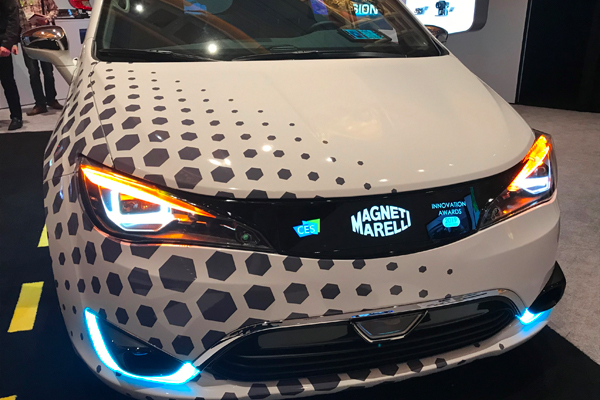14-janvier-2019
Building on the momentum of CES 2019, Magneti Marelli to exhibit award-winning Smart Corner™ for autonomous driving and seamlessly integrated connected vehicle technology at NAIAS 2019.

Magneti Marelli is demonstrating its third generation Smart Corner™ – unveiled last week at CES 2019 in Las Vegas – and connected vehicle technology at the North American International Auto Show (NAIAS) during AutoMobili-D in Detroit, Jan. 14-17, 2019.
Smart Corner™, named a CES 2019 Innovation Awards Honoree in the Vehicle Intelligence & Self-Driving Technology category, integrates autonomous sensors into headlamps and tail lamps to provide automakers with the required functionality for autonomous driving, while maintaining styling aesthetics and world-class lighting performance.
Smart Corner can accommodate any sensor an automaker may choose to deploy, including LiDAR, radar, cameras or ultrasonics, as well as advanced, LED-based lighting features like adaptive driving beam (ADB) and digital light processing (DLP). Smart Corner provides a 360-degree view around the vehicle with redundancy. Because the sensors are integrated into existing headlamps and tail lamps, an automaker benefits from a fully calibrated, plug-and-play solution, resulting in a simplified manufacturing process that’s lower cost and lighter weight than alternatives.
As an extension of its Smart Corner concept, Magneti Marelli has developed connectivity features that are seamlessly integrated into a test vehicle that will be on display at NAIAS. Technology includes active matrix organic light-emitting diode (AMOLED) displays embedded in the front grille and rear applique to communicate intent to pedestrians, bicyclists, and other vehicles; autonomous signaling to communicate to others that the vehicle is in autonomous mode; an interactive exterior virtual assistant that can perform commands for the driver and passengers such as opening the trunk or unlocking the doors when approaching the vehicle; positional advertising using V2X that provides targeted advertising, projected onto the windows, to individuals based on micro-location; and high power projection and film technologies to support the exterior virtual assistant and positional advertising functionality to achieve a viewable, high quality image from outside and inside the vehicle.
-
News2025-10-06De la piste à la ville : une expérience riche en adrénaline à Barcelone
-
News2025-09-30Magneti Marelli Parts & Services à EQUIP AUTO 2025 : Une présence dynamique et innovante inspirée par son ADN sportif et technologique
-
News2025-06-20Magneti Marelli Parts & Services élargit sa gamme d'ampoules avec de nouveaux produits
-
News2025-06-19Magneti Marelli Parts & Services lance une nouvelle gamme de compresseurs, complétant ainsi la gamme de pièces de rechange pour les véhicules équipés de suspensions pneumatiques.
-
News2023-10-12Ayez le réflexe Magneti Marelli Parts & Services !
-
News2023-10-11Magneti Marelli Parts & Services élargit son offre Amortisseurs avec le lancement d’une gamme de Kits de protection
-
News2023-08-29Antonio Giovinazzi | La star de notre vidéo « La haute performance commence dans la boîte »
-
News2023-06-14Antonio Giovinazzi, ambassadeur de la marque Magneti Marelli Parts & Services, remporte les 24 Heures du Mans
